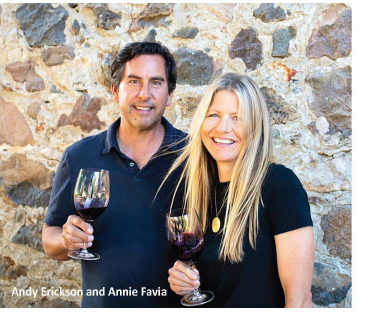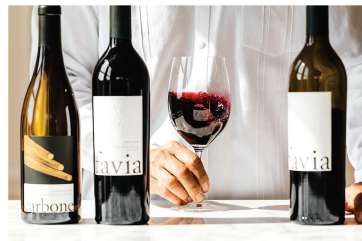Winemaker Andy Erickson has worked for many of Napa Valley’s most prestigious wineries and created Favia with his wife, renowned viticulturist Annie Favia.
This rockstar couple of winemaking met in 1994. They have both earned enviable resumes - Erickson making wine for cult wineries like Screaming Eagle and Harlan Estate and Favia working as a viticulturist for Napa icons like Cathy Corison.
The two would dabble in small production during their early years together. A single barrel of Russian River Valley Pinot Noir in 1996 would lead to the birth of the Favia label in 2001. The venture really began, though, in 2003 on a historic property in Coombsville which would be given AVA status less than a decade later.
The two thoughtfully restored their property with native plants and an orchard for greater biodiversity. They focused on organic and biodynamic practices while still consulting and working with other wineries in the region.
They would purchase select blocks of Cabernet Sauvignon grapes from the eastern hills of Oakville, higher above the valley floor where there are red, iron-rich soils along with using their own Coombsville estate fruit.
The demand quickly grew for their artisanally-produced, small 2,000-bottle wine production. Wine critics bestowed scores in the upper nineties on vintage after vintage and demand grew even more.
 The opportunity for their boutique label to blossom further finally arrived in 2023 when they formed a new partnership with the Huneeus family of Quintessa wines. The family had purchased an Oakville estate in 2018 that they thought would interest the couple.
The opportunity for their boutique label to blossom further finally arrived in 2023 when they formed a new partnership with the Huneeus family of Quintessa wines. The family had purchased an Oakville estate in 2018 that they thought would interest the couple.
They were indeed very interested in the potential the land held and are in the process of moving the winery to this new, but historic property. They will soon be located in the Oakville AVA on an 86-acre plot nestled between Opus One and Groth wineries.
Napa Valley wine aficionados will have to wait for a taste of this new venture, however. Production is still at the Coombsville property with plans for the Oakville winery to be built this year.
True to form, caring for the land was first and foremost on this Napa Valley dynamic duo's minds. Erickson recently shared at a trade tasting that “the property was cleared by the Huneeus family and allowed to lie fallow for two years which is virtually unheard of in Napa, creating a blank slate for us.”
He shared that plans include practicing organics and biodynamics to reinvigorate the land. They have also made use of a computer-generated plan for planting vines for lower irrigation needs.
 They are combining both a scientific and holistic approach to provide the best stewardship of the property which they have been working on in phases. Currently they have 65 of the 68 plantable vineyard acres under vine and Erickson said he expected the last couple of acres to be planted by next year.
They are combining both a scientific and holistic approach to provide the best stewardship of the property which they have been working on in phases. Currently they have 65 of the 68 plantable vineyard acres under vine and Erickson said he expected the last couple of acres to be planted by next year.
Grape varieties include Cabernet Sauvignon, Cabernet Franc, Malbec, and Sauvignon Blanc; all Bordeaux varieties for which the region is known.
Erickson said phase one of the winemaking side of things involved making small batches with the 2023 fruit. As a result of these experiments, he is excited about making a Merlot-based wine and a Sauvignon Blanc. He is also excited about making the Cabernet Sauvignon and Cabernet Franc wines for which Favia is known.
About a third of Favia wine is sold internationally, a third is sold to restaurants, and another third sold directly to consumers. Those looking to taste these luxury-priced wines should keep an eye on higher-end restaurant wine lists or join the Favia email list to learn about their current offers.
Favia can also occasionally be found at higher-end wine shops in very limited quantities. Online pricing from independent wine shops for the wines listed below ranges from $175 to $250 a bottle.
While not priced for everyday drinking for most, these luxury Napa reds could easily be held for a decade or more with proper storage by collectors. For those who like the occasional splurge for life’s victorious moments, these are wines that fit that bill, they are very celebration-worthy.
FAVIA WINES TASTED
2014 Favia La Magdalena Napa Valley Red Wine
This wine is a blend of 69 percent Cabernet Franc and 31 percent Cabernet Sauvignon. Unlike some wineries that want a specific recipe employed, there is not one used for this wine.
Erickson said he has fermented the grapes together and vinified them separately depending on what the vintage needed. 2014 was a cool year which defines this wine as it created more aromatic grapes with higher natural acidity.
This led to a still youthful, full-bodied yet bright and nimble wine loaded with juicy cherry and berry notes, floral notes, and a hint of mint. The wine has touches of earth and spice in a smooth and persistent finish.
2019 Favia La Magdalena Napa Valley Red Wine
This wine is 62 percent Cabernet Franc and 38 percent Cabernet Sauvignon and provides what Erickson called “the full spectrum of Cab aromas.” The wine showed red cherries, raspberries, floral violet with peppery notes and blackberry and blackcurrants, and cedar in a long, full-bodied mouth-coating finish.
2014 Favia Oakville Cabernet Sauvignon
This wine is still youthful and muscular with notes of juicy black fruit, cocoa, hints of leather and cedar with velvety tannins in a long, layered finish.
2019 Favia Oakville Cabernet Sauvignon
This wine is fresh and pure with intense aromas and rich flavors of cassis, dark chocolate-covered cherries with notes of pencil box, and hints of tobacco. The wine has a bit of spice in a full-bodied, big-structured velvety red with a lengthy finish.